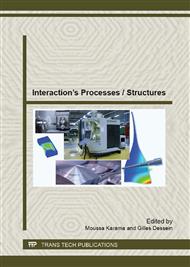p.1
p.11
p.21
p.29
p.39
p.49
p.59
p.69
p.79
Kinematic Behaviour Modeling of the Axes of a Machining Center in High Speed Milling
Abstract:
In the context of high speed milling HSM, the feed rate does not always reach the programmed value during the machining process which implies an increase of machining time and non compliance with the programmed feed rate. This phenomenon leads to productivity issues and an underestimation of the cost of machining for the industry. The aim of this study is to identify the kinematic behaviour of the machine tool during any type of discontinuity between linear and circular contours in different combination by taking into account the specific machining tolerances. In order to achieve this, a model of the law of the axes motion and the actual trajectory at discontinuities is necessary. This method is based on the subdividing of the trajectory into elementary geometries according to the type of interpolation (circular or linear). The proposed method can estimate the cycle time with a maximum error of 5% between the actual and the prediction cycle time. Finally, an experimental study was carried out on a high speed machine. It is based on elementary tests in order to analyze the axes behavior during any type of discontinuity and to validate the developed models.
Info:
Periodical:
Pages:
39-48
Citation:
Online since:
May 2013
Authors:
Price:
Сopyright:
© 2013 Trans Tech Publications Ltd. All Rights Reserved
Share:
Citation:


